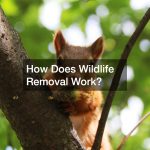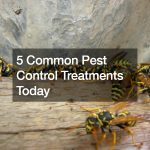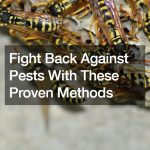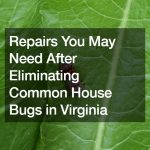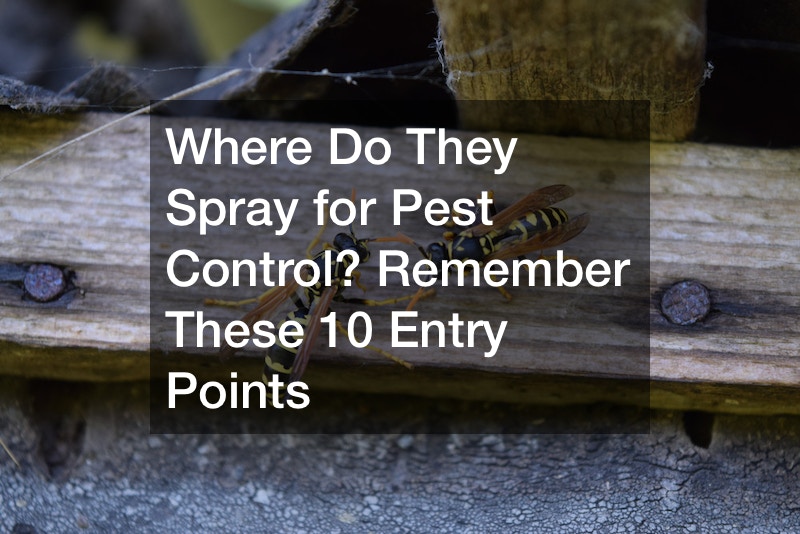
Where Do They Spray for Pest Control? Remember These 10 Entry Points
When you want to maintain a comfortable and safe living space, direct your focus toward pest control. You should focus on the location and how to address these challenging problems. Explore the various pest control entry points. In addition, we highlight the insightful tips for tackling the points of entry.

1. Gaps and Cracks in Walls and Floors
Several different pests enter your home through gaps and cracks in walls and floors. When you are wondering where do they spray for pest control, this is one of the top areas. A convenient access point for pests seeking shelter or food is the gaps in the walls. When you have pest control for common household pests, you can expect it to attack specific pets.
Tiny gaps around doors and windows can allow ants to enter your home. Once they get in through cracks in the foundation, they can establish trails to food sources. Cockroaches easily squeeze through small openings. Gaps are a path around plumbing and electrical entries for pests. Spiders enter your home through cracks near windows or doors. Spiders are mostly harmless, but some species can be venomous.
To prevent the entry of these and other common pets, seal these openings with caulk or expandable foam. Regularly inspect and maintain your home’s exterior to identify and address potential entry points. It’s essential to regularly inspect your home’s exterior for likely entry points and seal any gaps or cracks you find. If you are convinced there’s an infestation, consider a consultation with a pest control professional.
2. Wall Cavities and Eaves
If you notice bee activity, you may wonder where do they spray for pest control in this case. Bees, including honeybees and carpenter bees, often establish nests in wall cavities, eaves, or attic spaces. In this case, it’s crucial to hire professional bee exterminators to remove the nest safely. Attempting to remove bees without the right equipment and expertise can be dangerous.
Bee extermination is another name for bee removal or pest control. This is the process of eliminating or relocating bee colonies when they create a threat to human safety or property. There are several steps that must be conducted by trained professionals. Bee stings present a potential danger.
The first step is to identify the type of bee and assess the extent of the infestation. Different species of bees may require different removal methods. Honey bees and bumblebees are common bees you may find. Bee removal specialists wear protective clothing. You may see them in bee suits and gloves to prevent bee stings. They often use smoke to calm the bees during the removal process. Bee extermination should only be considered when there is a significant threat to human safety. Aggressive bee species or an infestation in a high-traffic area are times when it should be a consideration. Hire experienced professionals who can handle the removal safely and responsibly.
3. Attics and Crawl Spaces
Attics and crawl spaces are common entry points for a variety of pests seeking warmth and a place to breed. These spaces offer protection for pests from the elements. Larger pests like raccoons, squirrels, and bats seek refuge in attics and crawl spaces. A wildlife removal service specialize in safely capturing and relocating these animals. When you wonder where do they spray for pest control and proper exclusion techniques, consider how to prevent re-entry. In addition to spraying, sealing entry points and installing one-way exit devices are essential.
To prevent these pests from entering your attic or crawl space, consider the preventive methods. This includes sealing cracks, gaps, or openings in your home’s exterior. Don’t forget the eaves and vents. Install screens or vents with secure coverings to prevent entry while allowing proper ventilation. Work to keep trees and branches trimmed away from your home. This reduces easy access for squirrels and raccoons. Regularly inspect your attic and crawl spaces for signs of pests. Be on the lookout for droppings, nests, or chewed materials. Contacting a pest control professional helps to ensure safe and effective removal.

4. Overgrown Vegetation and Debris
Overgrown vegetation and debris can create the perfect conditions for various pests. They enjoy these spaces because they provide them with shelter and food sources. When you wonder where do they spray for pest control in these cases, think about bushes and shrubs. In addition, effective landscaping can deter pests from entering your home. Keep trees away from your exterior walls to reduce hiding places for pests like rodents. Remove debris, such as fallen leaves and branches, from your yard to eliminate harborage areas.
Overgrown vegetation and debris offer rodents hiding places and nesting materials. They are also attracted to food sources like fallen fruits or seeds in the vegetation. Standing water in debris can create ideal breeding sites for mosquitoes. Pools of stagnant water in debris become breeding grounds for mosquito larvae. Ticks and fleas thrive in tall grass and overgrown vegetation, waiting for passing hosts to latch onto. Pets and humans can easily pick up these pests when walking through such areas. To maintain a well-kept yard, promptly address overgrown vegetation and debris. This reduces the attractiveness of your property to pests. This also reduces the risks associated with infestations.
5. Yard and Garden
Local animal removal services handle a wide range of pests, including skunks. They also address groundhogs and moles. These animals can destroy your yard and garden. Professional animal removal services can safely trap and relocate these pests to ensure your property remains pest-free. When you’re thinking about where do they spray for pest control, consider that these services help homeowners deal with nuisance animals.
These animals cause damage or pose a threat to property or health. These animals dig up lawns and nest in attics or crawl spaces. Professionals use humane trapping methods to capture and remove animals from unwanted areas. Live traps are often used to catch animals without harming them. After removing animals, local animal removal services may perform exclusion work to prevent future infestations. This can include sealing entry points and installing barriers. This makes your property less attractive to wildlife.
Local animal removal services aim to promote the safe and ethical handling of wildlife. They also address concerns related to property damage and health risks. They often work in compliance with local and state regulations governing wildlife management and removal.

6. Rotted Wood
Rotting wood in your home’s structure can attract pests like termites and carpenter ants. Regularly inspect and repair any areas with rotted wood to eliminate this attractive entry point for pests. Consider using pressure-treated or composite materials for outdoor structures and landscaping features. Rot repair plays a crucial role in pest prevention by addressing structural weaknesses and moisture issues.
When thinking about where do they spray for pest control, consider that rot often occurs in wood structures. You can expect to see it in framing and siding. As wood deteriorates due to rot, it creates gaps and openings that pests can exploit to enter your home. Repairing and replacing rotted wood seals these potential entry points. A deal makes it challenging for pests to gain access.
Rot repair involves removing and replacing the damaged wood. This eliminates the habitat that pests are drawn to. All the while, this reduces the likelihood of infestations. Rot is often a result of moisture infiltration. This could be from leaks or plumbing issues. Repairing the source of moisture and replacing rotted wood helps to correct the underlying problem. By addressing moisture issues, you reduce the conditions that attract pests in the first place.
7. Pantries and Cabinets
Pests commonly enter homes through pantries and cabinets. Stored food products can become infested with pantry pests like beetles and weevils. Use airtight containers to store dry goods. You want to regularly clean and inspect your pantry and kitchen cabinet areas for signs of pest activity. If an infestation is detected, dispose of contaminated items and thoroughly clean the affected areas.
When you think about where do they spray for pest control, you want to take proactive measures and maintain a clean and organized kitchen. This reduces the risk of pantry and cabinet pests invading your home. Ants are notorious for infiltrating kitchen areas in search of food. They are drawn to sugary or greasy substances. They can quickly infest stored food items. Pantry moths are a common nuisance in kitchen areas. They lay eggs in stored grains, cereal, and other dry food products. The larvae can infest these items, leading to contamination. Mice and rats are skilled climbers and can access cabinets and pantries if there are any openings or gaps. They are attracted to food sources and can cause extensive damage to stored goods. If you have a constant pest problem, consult a professional. They point out the origin of the infestation.
8. Garage Access
Garages can serve as entry points for pests if not adequately sealed. Ensure that your garage doors close tightly and inspect for any gaps or openings. Installing weather stripping and door sweeps can help seal these entry points. Over time, the weatherstripping and seals on your garage door can wear out, leaving gaps and cracks that pests can exploit.
Garage door repair includes inspecting and replacing damaged weatherstripping and seals. Proper sealing prevents pests like rodents, insects, and snakes from finding their way into your garage. When you want to know where do they spray for pest control, think about the garage door panels. When they are damaged or have gaps, it can provide easy access for pests.
A garage door repair professional can assess the condition of your panels and replace any that are compromised. This helps maintain the integrity of your garage door and keeps pests out. During garage door repair, components are inspected and tightened. A well-maintained door operates smoothly and doesn’t leave gaps for pests. In some cases, it may be advisable to install pest deterrents such as screens or mesh on vents and openings in your garage. These barriers can prevent insects, birds, and other pests from gaining access while still allowing for ventilation.
9. Trash Receptacles
Proper trash management is crucial in pest control. Keep trash receptacles sealed and ensure they have tight-fitting lids. Regularly schedule local trash removal services to prevent trash buildup that can attract pests. Trash receptacles can attract pests due to the presence of food waste and odors. When you wonder where do they spray for pest control, you may want to consider other pest deterrents. Consider items like mothballs or ammonia-soaked rags in or around trash cans to discourage pests.
Even if you think your trash is free of food scraps, there may be residue or crumbs that pests find appealing. Food odors from discarded items can linger, drawing pests like flies and rodents. Throwing away leftovers or food that has gone bad can be a major attraction for pests. This is especially true if the trash receptacle is not properly sealed. Strong odors from rotting food and spoiled leftovers can attract pests from a distance. Pests like flies and scavenging animals have an acute sense of smell and will be drawn to the odor source.

10. Mattress and Bedding
Bed bugs are infamous for infesting mattresses and bedding. Invest in the highest rated mattress designed to resist bed bug infestations as a valuable preventive measure. Additionally, regularly inspect and clean your bedding and mattress to detect bed bugs early. Removing bed bugs can be a challenging and arduous process. When you think about where do they spray for pest control, you want to focus on mattress care.
Begin by isolating the infested areas to prevent bed bugs from spreading. Strip and wash all bedding and curtains in hot water and place them in sealed plastic bags. Steam cleaning is successful in killing bed bugs and their eggs. Use a steam cleaner to manage infested areas, such as mattresses and furniture.
Understanding where pests can enter your home is essential for productive pest control. By addressing these entry points and seeking professional assistance when needed, you can protect your home. Take these dynamic steps to ensure your home remains a comfortable and pest-free space.
